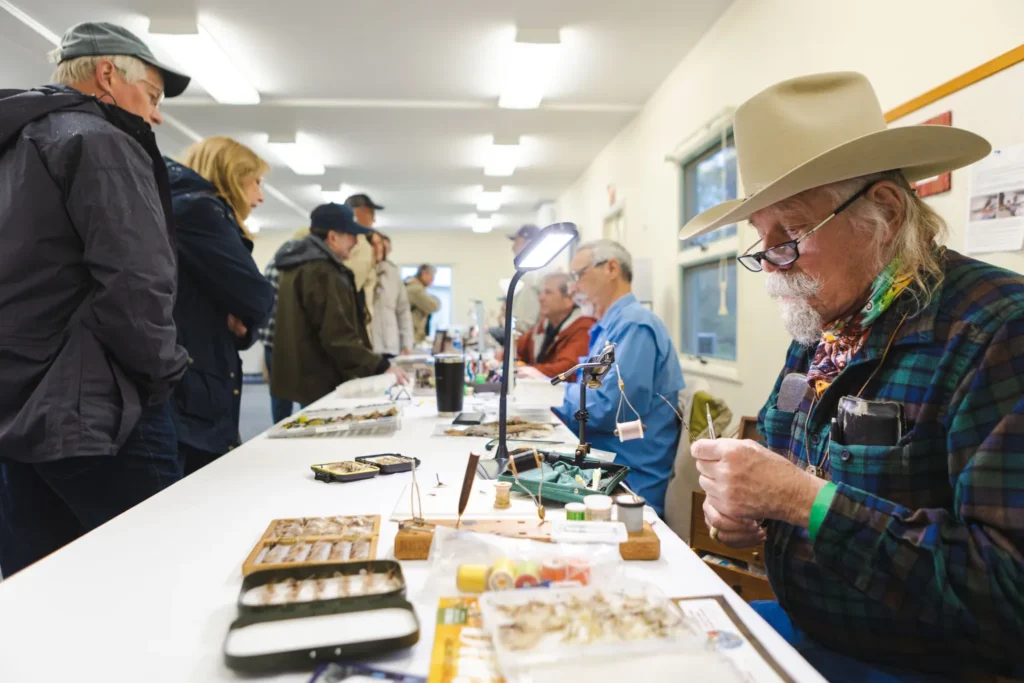Celebrating Vermont’s most famous river at the Battenkill Fly Fishing Festival
By Ethan Weinstein – May 2, 2023, 11:50 am

ARLINGTON — Doug Lyons locked eyes with the river, searching for the splashy rise of brown trout.
The warm, late April day had brought out Hendricksons, a favorite mayfly of the Battenkill’s devoted anglers. No other fly, Lyons explained, gets the river’s large fish feeding with such reckless abandon. By 3 p.m., the reddish brown flies, less than an inch in length, arrived above the water.
“There’s a lot of bugs, no question about that,” Lyons said, naming the stage of the insects as they flew past. Duns, the initial winged phase of the bug’s life cycle, first leave the water, where they previously survived as larvae. The duns molt into spinners, the final stage in a mayfly’s life. The female Hendrickson spinners, soon to die, carry a bright yellow egg sac, returning to the water one last time.
Finally, Lyons spotted it. Maybe 50 yards downstream, tucked alongside a submerged log, the mouth of a trout breached the water. Once, then again, the fish rose to eat a mayfly from the water’s surface. The hunt was on.
‘The Battenkill is back’
Since 1977, when he was not yet able to drive, Lyons has ventured from Massachusetts to Vermont to fish the Battenkill. Now, weeks into retirement, he’s looking forward to spending more time on the water.
Few can speak about the river with Lyon’s authority. He recently penned “Fly Fishing Guide to the Battenkill” — out this summer — condensing his decades of knowledge into book form. Highlighting the river’s history, its bug hatches and its honey holes, Lyons, a first-time author, was in town to speak at the second annual Battenkill Fly Fishing Festival in Arlington.
The festival, put on by The Arlington Common — a nonprofit project promoting community through arts and wellness — brought hundreds of fly fishers from around the East to fish and celebrate the Battenkill.
“To have this gem flow through our town, it needs our care,” said Bill Bullock, one of the festival’s organizers.
The Battenkill is famous among anglers for its large, selective brown trout. Unlike most rivers in Vermont, which require the stocking of hatchery-grown fish to support their trout populations, the Battenkill contains only wild fish in its Vermont section.
The river’s fame is due in part to its proximity to Orvis, which, based in Manchester, sits within casting distance of the Battenkill. One of fly fishing’s most recognizable brands, the retailer has named products for the stream, and its employees have long slipped away to the river for lunch-break casts or after-hours fishing.
Part of the river’s strength is geological. Numerous springs supply the stream with chilly groundwater, providing the cold water trout love throughout the summer. The Taconic Mountains that rise above the river, containing different rocks than the Green Mountains, offer nutrients like calcium and magnesium, which further bolster the river’s life.
In these conditions, the river’s brown trout can live six or seven years, exceeding 20 inches in length along the way. But the fish grow wise with age, and the Battenkill’s reputation as an exceedingly challenging stream makes any fish caught a small victory.
Through the festival, Bullock hoped to promote the river’s conservation while also highlighting its flourishing fish.
“Our number one goal was to make awareness that the Battenkill is back,” he said of the weekend.
In the 1990s and early 2000s, the river’s trout dwindled in number, particularly its middle-aged fish. After a bit of trial and error, biologists hypothesized the river’s lack of cover — places for fish to hide from predators such as eagles, osprey and mergansers — was likely causing trout numbers to decline.
So with the help of almost $1 million from various funding sources, the river’s defenders began to install woody debris along the banks, Bullock said. As various natural materials get pushed down the river, the fallen trees placed by human hands accumulate more sticks and leaves and weeds, integrating into the streamside and creating ideal habitat for trout to evade predation.
